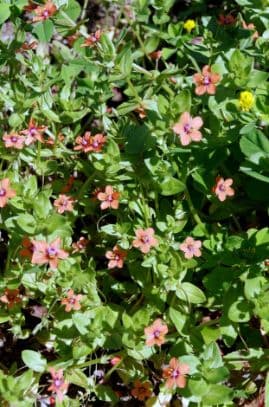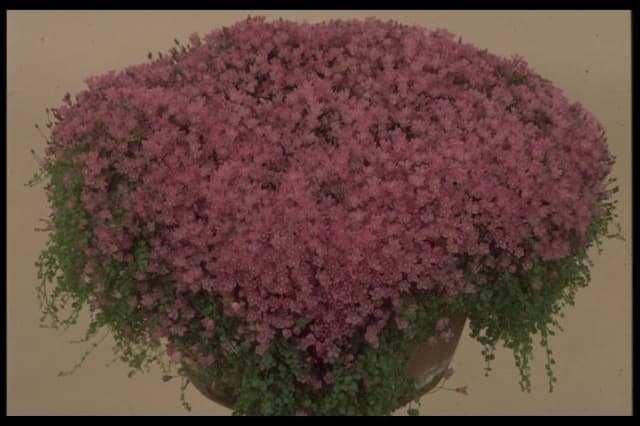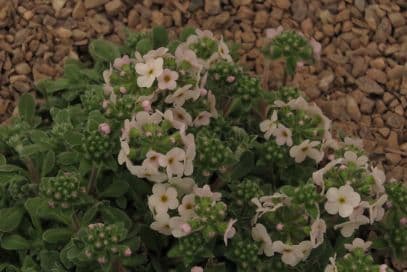Auricula Primula auricula 'Sibsey' (Au/d)

ABOUT
The Primula auricula 'Sibsey' is a captivating flowering plant known for its unique and eye-catching blooms. The flowers are typically a rich, vibrant shade of yellow, with a bold, contrasting center often referred to as the eye, which is a deep, velvety maroon or purple color. This contrast creates a striking display against the backdrop of the plant's foliage. The petals are rounded and arrange neatly in a rosette shape, exuding an almost artificial perfection that grabs attention. Surrounding the prominent flowers is a lush cushion of foliage. The leaves are soft to the touch, emanating a pale green hue with a slightly powdery or waxy coating that lends them a subtle sheen and helps in water retention. This coating also imparts a slight silver tint to the foliage, enhancing the plant's overall charm and giving it a somewhat frosted appearance. The leaf arrangement is compact and tidy, providing a dense green platform from which the flower stems rise and present their blooms. The Primula auricula 'Sibsey' is prized among garden enthusiasts for its ornamental flowers and its relatively easy care, often grown in gardens for its decorative appeal and sometimes as part of alpine collections or rockeries, where its striking appearance adds splashes of color and visual interest. It's a true gem in the garden, with its beautiful blooms that look like they've been painted by an artist's hand.
About this plant
 Names
NamesFamily
Primulaceae.
Synonyms
Bear's Ear, Mountain Cowslip, Auricula.
Common names
Primula auricula 'Sibsey' (Au/d).
 Toxicity
ToxicityTo humans
The Primula auricula, more commonly known as the Auricula or Bear's Ear, does not have significant toxic properties that pose serious harm to humans. However, some individuals might have skin reactions or dermatitis from handling the plant due to the presence of a compound called primin found in the foliage. While it is not considered a common edible plant, ingestion is unlikely to cause serious poisoning, but it may result in mild stomach upset if consumed in large quantities. It is always recommended to avoid ingesting plants that are not known to be edible, and to consult a medical professional if any adverse effects occur after handling or accidentally consuming any part of the plant.
To pets
The Auricula, or Bear's Ear, is not known to be significantly toxic to pets such as cats and dogs. Like with humans, the primary concern is the potential for mild dermatitis or skin irritation due to a compound called primin present in the plant's foliage. Ingesting this plant is not expected to cause serious health issues in pets, but as with all non-food plants, it could potentially lead to gastrointestinal irritation or mild stomach upset if consumed. If you suspect your pet has ingested a large amount of Auricula or is showing signs of distress, it's always best to consult with a veterinarian.
 Characteristics
CharacteristicsLife cycle
Perennials
Foliage type
Evergreen
Color of leaves
Green
Flower color
Yellow
Height
6 inches (15 cm)
Spread
6 inches (15 cm)
Plant type
Herb
Hardiness zones
5
Native area
Europe
Benefits
 General Benefits
General Benefits- Ornamental Value: Primula auricula 'Sibsey' is highly prized for its unique and attractive flowers, which add visual appeal to gardens and landscapes.
- Ease of Care: It is generally considered easy to care for, requiring minimal maintenance once established in suitable conditions.
- Pollinator Attraction: The flowers of the plant attract pollinators such as bees and butterflies, which are vital for the pollination of many plants.
- Seasonal Interest: This plant typically blooms in spring, providing early seasonal interest after winter when few other plants are flowering.
- Compact Size: Its compact growth habit makes it suitable for small gardens, borders, containers, and rockeries.
- Variety of Colors: The 'Sibsey' variety offers unique color variations that can provide a wide palette for garden design.
- Hardiness: It is relatively hardy and can survive in cooler climates, making it suitable for a range of garden zones.
- Long Blooming Period: Primula auricula 'Sibsey' often has a long blooming period, offering prolonged periods of colorful displays.
- Propagation: The plant can be easily propagated from offsets, allowing gardeners to expand their collection or share with others.
 Medical Properties
Medical PropertiesThis plant is not used for medical purposes.
 Air-purifying Qualities
Air-purifying QualitiesThis plant is not specifically known for air purifying qualities.
 Other Uses
Other Uses- Floral Art: The distinct shape and vivid colors of Auricula flowers make them excellent for use in floral arrangements or decorative displays.
- Photography: Due to their unique appearance, Auriculas are a popular subject among photographers, especially macro-photographers.
- Educational Tool: Botany educators use Auriculas to teach about plant biology and hybridization due to their diverse genetic background.
- Collectibles: Because of the numerous varieties of Auriculas, they are often collected by enthusiasts much like stamps or coins.
- Companion Planting: Gardeners plant Auriculas alongside other shade-loving plants to create aesthetically pleasing garden sections.
- Theater and Film: Auriculas can be used as part of stage arrangements or film sets to evoke a specific historical period or setting.
- Eco-Friendly Confetti: Dried Auricula petals can serve as biodegradable confetti for outdoor celebrations.
- Perfumery: Although not as common, some Auriculas may be used in the creation of fragrances due to their scent.
- Art Inspiration: The detailed patterns on Auricula petals are often used as inspiration by artists for paintings, illustrations, and textile designs.
- Cultural Symbol: In some cultures, the Auricula may represent uniqueness and rarity, making it a symbol in social and cultural events.
Interesting Facts
 Feng Shui
Feng ShuiThe Primula is not used in Feng Shui practice.
 Zodiac Sign Compitability
Zodiac Sign CompitabilityThe Primula is not used in astrology practice.
 Plant Symbolism
Plant Symbolism- Rarity: The specific cultivar 'Sibsey' of Primula auricula is less common than other garden varieties, symbolizing uniqueness and rarity.
- Patience: Primula auricula requires care and gradual cultivation, representing patience in growth and development.
- Perseverance: As a plant that can tolerate alpine conditions, it signifies the ability to endure and thrive in challenging circumstances.
- Precision: The 'Sibsey' variant, with its distinct patterns and colors, may symbolize the value of precision and attention to detail.
- Charm: With its attractive appearance, the Auricula is often associated with charm and the allure of natural beauty.
 Water
WaterThe Auricula, also known as Bear's Ear, should be watered deeply once a week, allowing the water to penetrate the soil to encourage deep root growth. The amount of water typically needed is about 0.5 gallons per plant, per watering session. Adjustments should be made during hotter, dryer periods, increasing to twice weekly, and reduced during cooler, wetter seasons to prevent overwatering. Always check the top inch of soil for dryness before watering to ensure the plant requires additional moisture. Overwatering can lead to root rot, so it's vital to ensure that the plant has well-draining soil.
 Light
LightAuriculas thrive best in bright, indirect light, as direct sunlight can cause the leaves to scorch. An ideal spot would be one where the plant is shielded from the harsh afternoon sun, possibly receiving filtered light through a sheer curtain if grown indoors, or partial shade if planted outdoors. East or North-facing locations can provide the optimal light conditions for the Auricula's healthy growth.
 Temperature
TemperatureAuriculas prefer cooler temperature conditions and can generally tolerate temperatures between 40°F and 75°F. They can survive minimum temperatures of just above freezing, but it's best for their health to avoid prolonged exposure to temperatures below 40°F or above 80°F. The ideal temperature range for Auriculas is between 50°F and 70°F, ensuring they're safeguarded from extreme weather.
 Pruning
PruningAuriculas benefit from pruning primarily to remove dead or fading flowers and leaves, which encourages fresh growth and improves the overall appearance. This should be done after blooming, typically in the late spring or early summer. Pruning can also help prevent disease by increasing air circulation within the foliage. Prune sparingly, focusing on deadheading spent blooms and cutting back any damaged or diseased foliage.
 Cleaning
CleaningAs needed
 Soil
SoilThe Bear's Ear plant thrives in well-draining soil with a peat moss base, mixed with perlite and a bit of lime to maintain a slightly alkaline pH between 6.0 and 7.0.
 Repotting
RepottingBear's Ear plants typically need repotting every couple of years or when they outgrow their current container, to refresh the soil and allow room for growth.
 Humidity & Misting
Humidity & MistingBear's Ear prefers moderate to high humidity levels, ideally between 50% and 60%, but can tolerate slightly drier air.
 Suitable locations
Suitable locationsIndoor
Place Bear's Ear in bright, indirect light and keep soil moist.
Outdoor
Grow Bear's Ear in partial shade with shelter from strong winds.
Hardiness zone
3-8 USDA
 Life cycle
Life cycleThe Primula auricula 'Sibsey', commonly known as Auricula, begins its life cycle as a seed, which once sown, germinates to produce small seedlings. These seedlings grow into rosettes of fleshy leaves, and given proper care, will develop a strong root system. The plant enters a vegetative stage, during which it produces more leaves and gains size and strength. The Auricula then reaches maturity and enters the reproductive stage, typically in the spring, where it produces stalks topped with clusters of brightly colored flowers, often in shades of yellow, red, or purple. After pollination, which can be aided by insects, the flowers will develop into seed pods, and once the seeds mature, they are dispersed to restart the cycle. The plant may then go into a period of dormancy, especially in colder climates, before re-emerging in the next growing season.
 Propogation
PropogationPropogation time
Spring-Early Summer
The most popular method for propagating Primula auricula 'Sibsey', commonly known as Auricula Primrose, is by division. This should ideally be done in the late summer or early fall after the flowering season has ended. To divide an auricula, carefully lift the plant from the soil and gently tease apart the offsets from the main clump with your hands, ensuring that each division has a portion of the root system intact. These divided clumps can then be directly replanted into well-draining soil at a similar depth to which they were growing previously. Water the newly planted divisions lightly to settle the soil around the roots and establish them in their new location. Division is an efficient way to create new plants that are genetically identical to the parent and will usually flower the following season.









